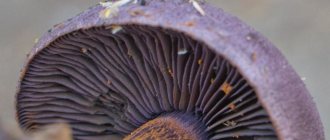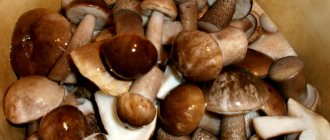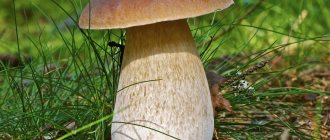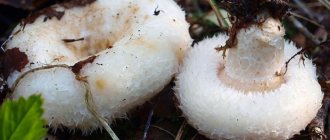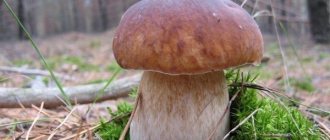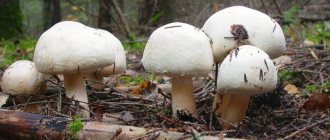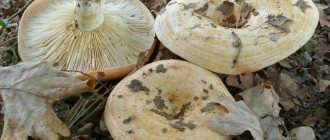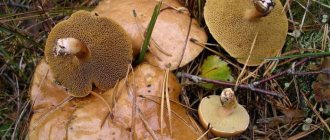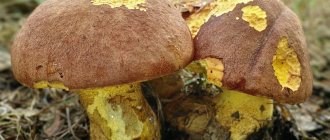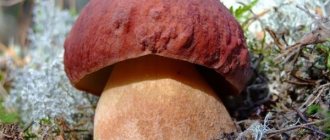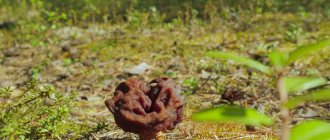Short description
| Type of mushrooms: | edible |
| Other names (synonyms): | Kolosovik |
| Latin name: | Boletus betulicola |
| Family: | Boletaceae |
| Distinctive feature: | White birch mushroom is a wonderful edible mushroom. As the name suggests, this type of Boletus forms a symbiosis with birch. |
| Beginning of the season: | June |
| End of season: | October |
| Leg height (cm): | 5-2 cm |
| Cap width (cm): | 5-15 cm |
| Smell: | nice, mushroom |
| Taste: | not expressed |
| Tasting score: | [kkstarratings] Have you tried this mushroom? Then rate it! |
| Hat: | convex at first, then flatter. The cover is smooth, slightly wrinkled, glossy, whitish-ocher or light yellow, sometimes almost white. |
| Leg: | barrel-shaped, solid, whitish-brown, with a white mesh in the upper part. |
| Hymenophore (bottom of cap): | white, then light yellow, tubular. The tubes are 1-2.5 cm long, the pores are rounded and small. |
| Disputes: | spore powder is brown, spores are 15 × 5 µm, fusiform, smooth. |
| Pulp: | white, compacted, does not change color when cut. |
| Natural environment and mycorrhiza: | forms mycorrhiza with birch, usually grows on forest edges and along roads. |
| False doubles: | Gall mushroom is an inedible mushroom with bitter pulp, characterized by a tubular layer that turns pink with age, the surface of the stem with a rough mesh, the mesh has a darker color than the main color of the stem. Porcini mushroom and its varieties are edible mushrooms. |
| Growing: | – |
| Use: | edible mushroom, valued and consumed in the same way as porcini mushroom. |
| Medicinal properties: | – |
| Spreading: | most common in the northern part of the temperate zone from the Murmansk region and further south, found in Western and Eastern Siberia, the Far East, known in Western Europe (Sweden, Finland, France). Occurs frequently, in some places very abundantly. Fruiting singly or in groups. |
The porcini mushroom is presented in several guises, each of which has its own color of the fruiting body. In addition, any given species will only grow near a certain type of tree. The white birch mushroom, for example, grows under birch trees. It is very useful for the human body, and is also incredibly popular in cooking, as it makes the taste of the dish piquant and original.
Appearance
The cap of the mushroom is small, its diameter varies from 6 to 12 cm. The skin is smooth, after rain it is slippery. The color of the cap can be either ocher or pale yellow. The cap is cushion-shaped when young, but as the mushroom ages it becomes prostrate.
The stem of a porcini mushroom looks like a barrel; in the middle this part has a thickening. The stem has a mesh pattern, the color of which is somewhat paler than the cap. The width of this part of the mushroom varies from 4 to 5 cm, and the length is 6-12 cm.
The pulp of the porcini mushroom is colored white, its taste is neutral. When broken, the flesh does not change color.
The hymenophore is sometimes accretive, but most often the spore layer is free. As the mushroom ages, it becomes more yellow. Hymenophore tubular, brown spore powder. The spores are spindle-shaped.
Where do white birch mushrooms grow?
The species can be found almost throughout the entire country. But more often it is found in northern regions with a fairly cold climate - in Siberia and the Murmansk region, in the Far East. White birch boletus chooses mixed forests and birch groves for growth; it appears most often under birch trees, but can also grow near other deciduous trees. You can see the spikelet on forest edges and near roadsides.
Doubles
The white birch mushroom is easily confused with many of its edible counterparts. For example, it is very similar to the lemon-yellow porcini mushroom. The twin can be distinguished by its bright yellow cap when young, and when mature – by white spots on the brown cap.
And the alpine porcini mushroom differs from its edible counterpart in its white, almost transparent cap.
A dangerous double of the white birch mushroom is the gall mushroom.
Bile mushroom
The twin can be distinguished by its brown cap and easily peeled off skin. An important feature of the poisonous double is the mesh pattern on the stem, which is several tones darker than the cap. The tubular layer of the false mushroom is pink, which becomes more noticeable when pressed. The pulp of the gall mushroom tastes bitter - this will also help to distinguish it.
Another edible counterpart of the white birch mushroom is the common boletus mushroom.
Common boletus
The double has a very plump and large cap, its diameter can reach 15 cm. It is easy to distinguish the boletus - it has a dark brown cap, which in damp conditions quickly becomes covered with sticky mucus. You can find gray scales on the stem of the double, which are impossible to find on the porcini mushroom.
The oak porcini mushroom is similar to the white birch mushroom. You can distinguish the double by the color of its cap - its one is darker and colored coffee-colored. The leg has the same dark color.
Oak white mushroom
Use in cooking
Kolosovik has excellent taste. Thanks to this you can:
- salt;
- dry;
- fry;
- cook
In any of the proposed options, the mushroom will be tasty and satisfying. If you dry the spikelet, it will remain white, just like when fresh.
Buckwheat with mushrooms recipe
To prepare the dish you need the following ingredients:
- buckwheat – 400 g;
- mushrooms – 250 g;
- onion – 4 heads;
- garlic – 4 cloves;
- dried mushrooms – 4o g;
- dill – 1 bunch;
- salt - to taste.
Procedure:
- Prepare all the products: finely chop the greens, cut the onion into cubes, and finely grate the dried mushrooms into powder.
- Pour boiling water over the buckwheat, keeping the ratio 1:3. Add salt, mushroom powder, cover with a lid and top with a towel. Leave the cereal for 20 minutes.
- Pour sunflower oil into a frying pan and fry the onion in it. Add porcini mushrooms and simmer for 15 minutes.
- Place buckwheat in a frying pan, along with garlic and herbs. Mix everything, cover with a lid and cook for 10-15 minutes.
It is best to serve the prepared dish in clay pots, then it will retain its heat longer.
Cooking mushroom omelet
Required ingredients:
- egg – 4 pcs.;
- onion – 1 head;
- porcini mushrooms – 200 g;
- natural yogurt – 2 tbsp. l.;
- low-fat cheese – 30 g;
- salt, pepper - to taste.
Procedure:
- Fry the chopped onion in a frying pan, add pieces of mushrooms, salt and pepper.
- A few minutes before readiness, add yogurt.
- In a separate bowl, beat the eggs, add salt and pour them into the pan.
- The omelette should be cooked over low heat, covered with a lid. Cooking duration is 3-5 minutes.
- Place the finished dish on a plate and sprinkle on top with fried mushrooms, onions and cheese, previously grated.
Growing and care at home
Porcini mushroom can be cultivated in the garden, but to do this you need to organize a symbiosis between the mushroom and the tree. Therefore, the site should be located close to a forest or grove. This mushroom is grown from spores that are located in the cap, from mycelium and pieces of mycelium.
During cultivation, the porcini mushroom needs to be watered partly. Before frost, the area should be insulated by placing straw or leaves on the mushroom growing area. Usually the harvest will please you within a year.
Distribution and collection
The distribution area is wide, this mushroom is also found in Central Russia, but it feels best in Eastern and Western Siberia, the Murmansk region, Scandinavia and Western Europe. Prefers mixed and deciduous forests, birch groves, grows well on roadsides and along forest paths.
White birch mushroom.
The birch porcini mushroom reaches its highest yield in July-September, but is found from June to October.
Interesting Facts
- The birch porcini mushroom ripens in just 9 days, like many of its brothers.
- This mushroom should be cooked no more than 10 hours after cutting due to the fact that the mushroom loses many useful substances during this time.
- Mushrooms that ripen in autumn ripen much longer than summer ones, but their mass is greater.
- When collecting a mushroom, you need to carefully remove it from the soil, because if the mycelium is damaged, the mushroom will never be able to develop in this place.
The decoction that remains after cooking the mushroom should not be eaten - the water can absorb harmful metal compounds that the mushroom picked up from the soil.
Use
Edible white birch mushroom is used in almost all preparations. Since it is still not recommended to eat the spikelet raw, it must be processed after collection.
Preparation consists of clearing the fruiting bodies of all adhering forest debris, washing them under cold water, and then boiling them with salt for about 15-30 minutes.
For cooking, take only young, strong and untouched mushrooms - if the spikelet is eaten by worms and insects, it must be trimmed to clean pulp.
The decoction from the fruiting bodies is drained and not used for food. Although there are no toxic substances in the pulp of the spikelet, there may remain harmful substances in the water that the fungus has managed to collect from the soil and air.
After boiling, white birch boletes can be eaten boiled or fried. The fruiting bodies are also salted and pickled, this allows them to be preserved for the winter. Fresh spikelets can be dried, in which case there is no need to cook it, just shake off the debris from the caps and stems, and then hang the mushrooms on a thread and wait until they dry completely and the moisture evaporates.
Advice! After collection, birch mushrooms must be processed within 24 hours - the spikelets lose their freshness quite quickly.
Growing methods
Typically, spikelets are grown using mycelium or spores.
- In the first case, planting material is bought in a special store and planted next to a birch tree on your site.
- In the second, they collect overripe mushrooms in the forest and soak the caps in 10 liters of water for a couple of hours. Then add 10 pieces of sugar and knead the mushroom pulp with your hands, after which they are planted on a previously prepared bed and sprinkled with substrate.
In addition, birch trees can be grown from part of the forest mycelium, which is dug up and transferred to the garden. Some gardeners grow crops from dried pieces after soaking them in water.
The planting site should be fertilized with compost and watered well, and covered with a dry leaf or straw for the winter.
The value of boletus
Of all the mushrooms, boletus is considered the king - not only attractive, but also the most delicious and healthy species. Its flesh is firm, aromatic with a sweet aftertaste. Its benefit lies in its high protein content, so its composition is equal to meat, but its calorie content is quite low - about 30 kcal.
The mushroom has tonic, healing and antibacterial properties, in addition to vitamins A, B and C.Medicine successfully uses this product in the fight against tuberculosis, increasing the body's metabolism as a whole, and even in the treatment of ulcers. You can prepare boletus in any available way: fry, marinate, stew and dry.
It is important to know that boletus is capable of absorbing toxic chemical elements, so it should be collected away from industrial enterprises and in a forest belt located away from the roadway.
It is contraindicated for diseases of the gastrointestinal tract, kidneys and liver.
Similar species and dangerous doubles
All other varieties of boletus mushrooms are externally similar.
Somewhat reminiscent of his little creatures - boletuses and boletuses. Of the conditionally edible species, bittergrass is considered a double. The flesh of the latter turns slightly pink when cut, and the taste is distinguished by strong bitterness.
Much more dangerous is the “satanic mushroom”, which accumulates poisons and can lead to poisoning. There is an external similarity between it and the spikelet, but there are also significant differences. So, the cap of the first one is more olive than ocher, and the leg below is of a reddish hue. When cut, its flesh turns blue-purple.
Determining a place for gathering
Determining the place where the porcini mushroom grows is quite a difficult task. When gathering in the forest, it is necessary to take into account all the basic characteristics and conditions necessary for growth.
Where to look:
- In old forests, no matter whether it is deciduous or coniferous.
- At the foot of trees, especially in places where they accumulate.
- Pay attention to the presence of moss and lichens.
- A wonderful place is when the forest directly opens to the water; in such places a lot of boletus mushrooms usually accumulate.
- A coniferous variety of porcini mushroom, prefers loamy and sandy soils, located mainly in well-shaded places.
Where not to look:
- Under single trees.
- In a well-lit part of the forest, since the boletus loves a lot of moisture.
- In open fields.
- In very young forests, in such forests, the soil has not yet collected the necessary amount of moisture and minerals that could suit our handsome man.
It is important to know where to collect them!
Contraindications and harm
The mushroom is contraindicated for children under 7 years of age, as well as for pregnant women. In addition, the product is prohibited in the following cases:
- metabolic disease;
- reduced acidity of stomach juice;
- pancreatic diseases.
Spikes have a very low glycemic index, so they do not increase the amount of glucose in the blood and do not disrupt the functioning of the pancreas. Thus, mushrooms are allowed for people suffering from diabetes.
If after eating the spikelet your health worsens, then this may be due to an allergy to this product. It is impossible to get poisoned by them.
Healing properties of mushroom
In addition to being used in cooking, spikelet is widely used in folk medicine. This mushroom is superior to many other species in terms of the amount of vitamins and nutrients. It contains antibiotics that destroy Koch bacilli. It has an analgesic, anti-inflammatory and wound healing effect. Kolosovik alleviates the condition of a cancer patient during irradiation, when he experiences vomiting, weakness and pain.
The mushroom contains beneficial amino acids, vitamins, macro and microelements, animal starch, carbohydrates and proteins. However, they contain slightly less vitamins PP and B2 than other forest mushrooms.
This valuable product has useful properties, namely:
- stimulates digestion processes;
- helps to recover faster from illness;
- destroys harmful microbes;
- eliminates inflammation;
- restores hair;
- strengthens nails;
- restores the functioning of the heart muscles;
- capable of thinning the blood;
- relieves depression;
- stimulates intellectual activity;
- fights hypovitaminosis.
An infusion of this mushroom has been used since ancient times for frostbite, wounds and inflammation, and joint pain. It is necessary to apply a cloth soaked in mushroom medicine to the sore spot 2 times a day. This will help stimulate healing.
The infusion is also consumed orally and prepared according to the following recipe:
- You need to take 2 tablespoons of dried spikelets and pour them into glasses of vodka or alcohol.
- The infusion should stand for 7 days in a place protected from the sun.
- Drink the medicine morning and evening, a teaspoon, which is first dissolved in 200 ml of water. The course of treatment is 3 weeks. Then you need to take a week break and take the medicine for another 21 days.
From the white birch mushroom you can prepare a unique remedy for strengthening hair. It is necessary to pass 1 teaspoon of dried spikelets through a meat grinder, add a little burdock oil to them and apply the resulting composition to the roots and along the entire length of the hair. After 15 minutes, wash off the mask. This procedure should be carried out twice a week.
Dried mushrooms, from which medicinal powder is made, are also useful. Take it 1 teaspoon three times a day with water. This should be done 30 minutes before eating.
About the forms of mushrooms
The most popular among the 18 forms are spruce, oak, pine and birch boletuses:
- Spruce boletus mushroom. It grows in the central zone of northern Russia, in spruce and mixed forests. Its cap has a light brown or brown tint. The rather long leg widens towards the base. From mid-July to early September is the time to collect these mushrooms.
- Oak boletus. The mushroom has a brownish cap with a gray tint. Found from July to early October in preserved oak forests. This form is thermophilic.
- Pine boletus. This is a stockier mushroom with a dark red-brown colored cap. The leg at the bottom becomes very thick. Found from July to September in light pine forests with sandy soil.
- Birch boletus. It is found in June-October mainly in birch and mixed forests. The color of the cap is reddish-yellow or light brown. The short leg is thick.
All these types of mushrooms are edible.
